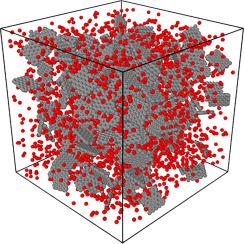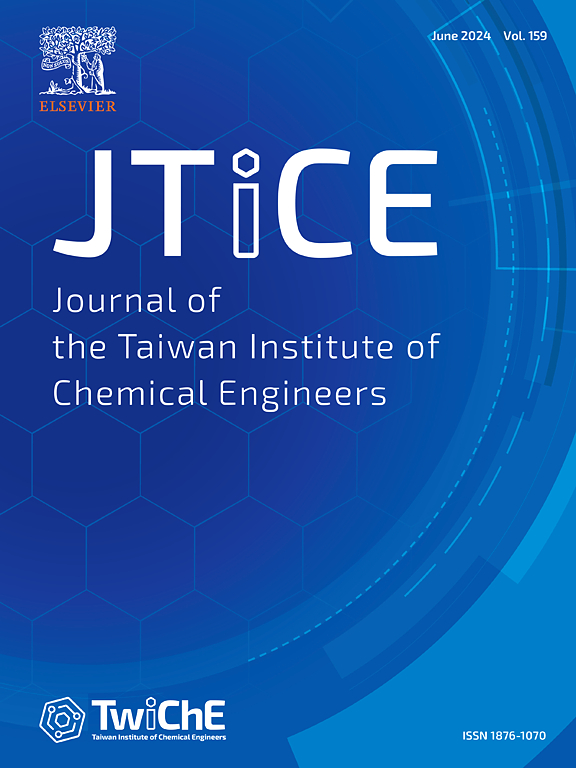分子动力学方法研究以石蜡为相变材料的增强型石墨烯气凝胶在不同外部热通量下的相互作用能和力学性能
IF 5.5
3区 工程技术
Q1 ENGINEERING, CHEMICAL
Journal of the Taiwan Institute of Chemical Engineers
Pub Date : 2024-09-26
DOI:10.1016/j.jtice.2024.105777
引用次数: 0
摘要
背景石墨烯气凝胶(GA)以其优异的轻质和坚固特性而闻名,为提高热能(TE)存储和传输效率提供了一条前景广阔的途径。通过研究热通量(HF)如何影响石墨烯气凝胶的强度和稳定性,有可能在电子、航空航天和能源存储等领域制造出更好的热管理系统。方法该研究使用分子动力学(MD)模拟来研究用石蜡作为相变材料(PCM)强化的石墨烯气凝胶的机械性能如何随外部热通量(EHF)而变化。这些模拟方法提供了原子水平上分子相互作用和动力学的详细视图,使研究人员能够了解材料在各种条件下的行为。重要发现结果表明,当 HF 从 0.1 W/m2 增加到 0.3 W/m2 时,极限强度和杨氏模量分别从 8.91 和 5.37 GPa 增加到 14.546 和 8.59 GPa。当 HF 增加超过 0.3 W/m2 时,这些值有所下降。当 EHF 上升到 0.3 W/m² 时,这些石墨烯气凝胶特性也随之上升。这是因为原子之间的移动更多,石墨烯薄片之间的结合接触也更多,从而使材料的结构更加坚固。然而,当热流水平超过 0.3 W/m² 时,过多的热能可能会导致热降解,造成键断裂和结构完整性丧失,最终导致这些机械性能下降。研究结果还显示,当外部高频增加到 0.3 W/m2 时,相互作用能从 -1522.098 eV 增加到 -1546.325 eV。原子的热运动随着高频的增加而增强,使石墨烯薄片更紧密地聚集在一起并更好地排列,从而加强了它们之间的相互作用。这项研究为我们提供了如何在不同高频条件下改善石墨烯气凝胶机械性能的有用信息。这使得这些材料更有可能用于储能系统和热管理。本文章由计算机程序翻译,如有差异,请以英文原文为准。

Molecular dynamics method to investigate the interaction energy and mechanical properties of the reinforced graphene aerogel with paraffin as the phase change material in the presence of different external heat fluxes
Background
Graphene aerogels (GA), known for their exceptional lightweight and sturdy characteristics, present a promising avenue for improving thermal energy (TE) storage and transfer efficiency. It might be possible to make better thermal management systems in fields like electronics, aerospace, and energy storage by studying how heat flux (HF) affects the strength and stability of graphene aerogels.
Methods
The study used molecular dynamics (MD) simulation to investigate how the mechanical properties of graphene aerogels strengthened with paraffin as phase change material (PCM) change in response to external heat flux (EHF). These simulation methods provided a detailed view of molecular interactions and dynamics at the atomic level, allowing researchers to understand the behavior of materials under various conditions. The change in toughness, interaction energy (IE), Young's modules (YM), and ultimate strength (US) was examined for this reason.
Significant findings
The results indicate that when the HF increased from 0.1 to 0.3 W/m2, the ultimate strength and Young's modules increased from 8.91 and 5.37 GPa to 14.546 and 8.59 GPa, respectively. These values declined when HF increased by more than 0.3 W/m2. When EHF went up to 0.3 W/m², these graphene aerogel properties went up. This was because the atoms moved around more and there were more bonding contacts among the graphene sheets, which made the structure of material stronger. However, at heat flux levels exceeding 0.3 W/m², excessive thermal energy may lead to thermal degradation, causing bond breakage and loss of structural integrity, ultimately resulting in a decrease in these mechanical properties. Also, the results reveal that interaction energy increased from -1522.098 to -1546.325 eV as external HF increased to 0.3 W/m2. The thermal motion of atoms enhanced as the HF increased, enabling closer clustering and better alignment of graphene sheets, thereby strengthening their interactions. This study gave us useful information about how to improve the mechanical properties of graphene aerogels in different HF conditions. This made it more likely that these materials can be used in energy storage systems and thermal management.
求助全文
通过发布文献求助,成功后即可免费获取论文全文。
去求助
来源期刊
CiteScore
9.10
自引率
14.00%
发文量
362
审稿时长
35 days
期刊介绍:
Journal of the Taiwan Institute of Chemical Engineers (formerly known as Journal of the Chinese Institute of Chemical Engineers) publishes original works, from fundamental principles to practical applications, in the broad field of chemical engineering with special focus on three aspects: Chemical and Biomolecular Science and Technology, Energy and Environmental Science and Technology, and Materials Science and Technology. Authors should choose for their manuscript an appropriate aspect section and a few related classifications when submitting to the journal online.

 求助内容:
求助内容: 应助结果提醒方式:
应助结果提醒方式:


